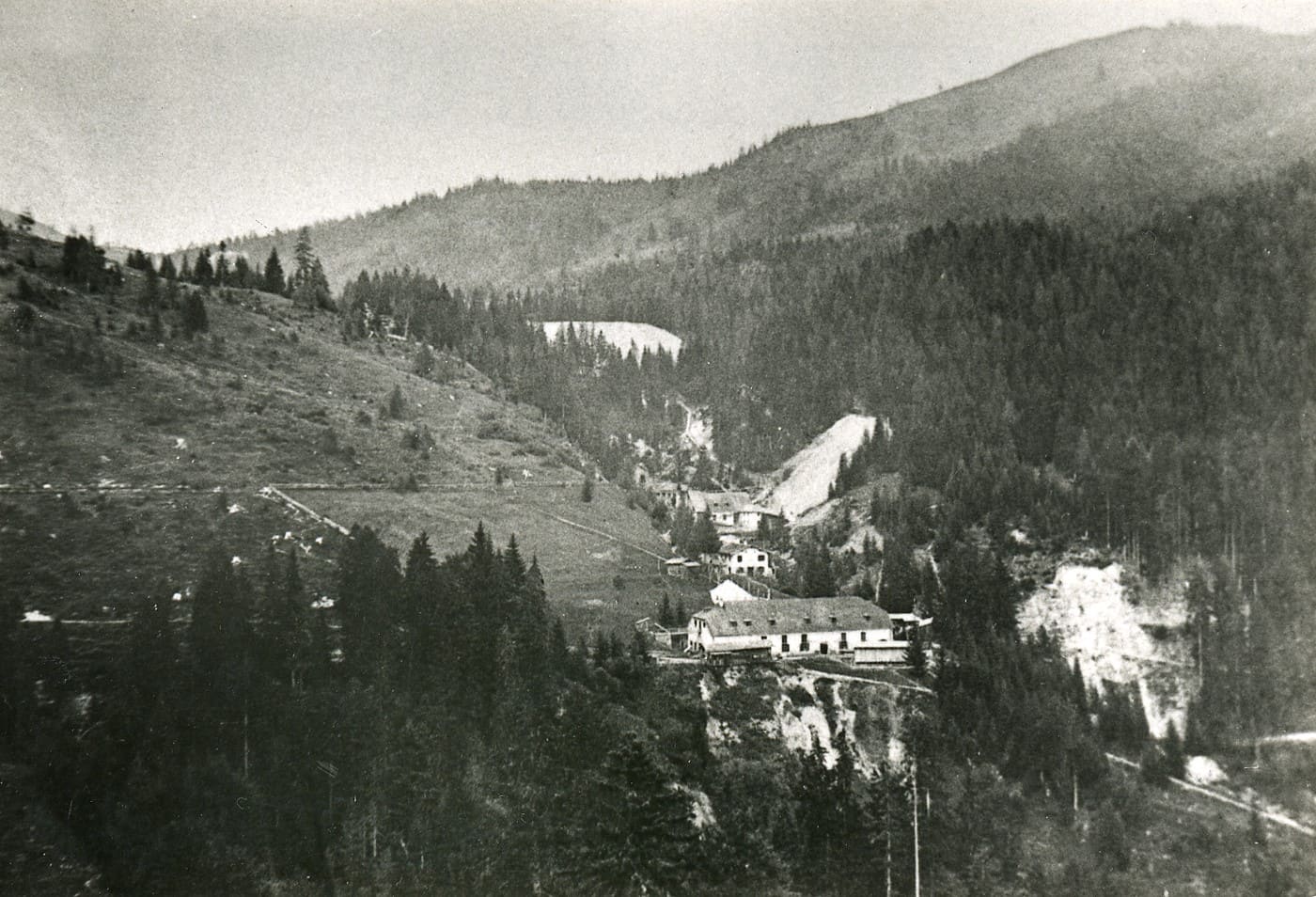Ore Crushing and Washing Plant #3
Sepp Bradl Sportshall
In 1858, the 3rd punching and washing mill was built on this site. This was followed in 1876 by the construction of the coarse rolling mill and, approx. 200 metres further down, the fine rolling mill. Both plants were used to crush and process the copper ore extracted from the mountain.
From the year 1966 onwards, these mining
facilities were converted into the "Nordic
Training Center Hochkönig.“ The idea
of a training camp for Nordic sports
was born in Lahti, Finland. After lengthy
discussions, Sepp Bradl (national ski
jumping coach) and Hugo Kassel (of the Bischofshofen Ski Club ) concluded that action
needed to be taken if Austria‘s ski jumping
sport was to continue competing with the
world elite.
The following measures were necessary for
this:
• Construction of a 60-meter training hill
(Riedingschanze)
• Construction of the Hochkönig Sports
Hall
• Renovation of the Rudolfschanze
(Arthurhaus)
• Construction of the 80-meter
Wetterwandschanze
You can learn more with a detour into the
Riedingtal (about a 30 minute walk).
Kids
Mühlbach am Hochkönig
Mühlbach am Hochkönig has a long history and has been known for its copper mining for many years. The first mention of the village as "Mulpach" dates back to 1350. In 1519, construction of the Sebastian Chapel began under Salzburg Archbishop Leonhard von Keutschach.
People were already mining copper in Mühlbach 4,000 years ago. In 1827, a farmer accidentally found a piece of ore, which led to the founding of the "Mitterberger Kupferwerkschaft". This group of 51 investors started the first copper mining operation in 1829, which soon became one of the largest in Central Europe.
Unfortunately, the copper mine in Mühlbach had to close on 30 June 1977 because the price of copper had fallen on the world market. Today there is a mining museum and a show gallery where visitors can learn a lot about the exciting history of mining.
Mühlbach am Hochkönig
Mühlbach am Hochkönig is a village with a fascinating history that has been known for its copper mining for many years. The first documented mention of the village as "Mulpach" dates back to 1350, and construction of the Sebastian Chapel began in 1519 under Salzburg Archbishop Leonhard von Keutschach.
People were already mining copper in Mühlbach 4,000 years ago! An important chance discovery was made in 1827 by a farmer who found a piece of ore. This led to the founding of the "Mitterberger Kupferwerkschaft" in 1829, in which 51 investors were involved. This group started the first copper mining operation, which quickly became one of the largest in Central Europe.
Unfortunately, the copper mine in Mühlbach had to close on 30 June 1977 because the price of copper on the world market had fallen. Today there is a mining museum and a show gallery where visitors can learn a lot about the exciting history of mining.
Mühlbach am Hochkönig
The first documented mention of the village of Mühlbach am Hochkönig as "Mulpach" dates back to 1350. Construction of the Sebastian Chapel began in 1519 under Salzburg Archbishop Leonhard von Keutschach. Today, Mühlbach has an internationally recognised position as a millennia-old centre of copper mining in Europe. Traces and finds indicate that Mühlbach was a 1700-year-old prehistoric industrial centre that reached its heyday in the period from 2,000 to 300 BC. Slag dating back 4,000 years can be found at over 190 documented smelting sites. For around 2,000 years, the old mining industry of the Mühlbacher Mitterberg remained hidden from people. After a chance discovery by a farmer, the "Mitterberger Kupferwerkschaft" was founded on 25 November 1829 by Josef Zötl, the then royal and imperial head miner from the Pillersee ironworks in Tyrol, with 51 donors. The first mine, the Mariahilf Stollen on the Roßbach, was opened in the same year. This ore mine developed into one of the largest copper mines in Central Europe. The fall in the price of copper on the world market led to the closure of the copper mine in Mühlbach am Hochkönig on 30 June 1977. Today, the mining museum and the show tunnel bear witness to a mining history that stretches back 4,000 years.



